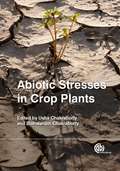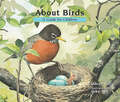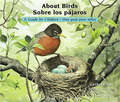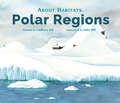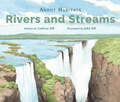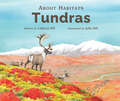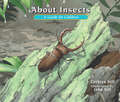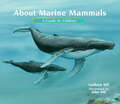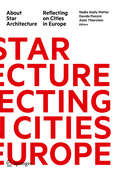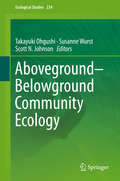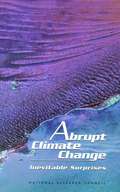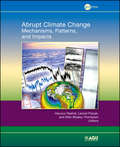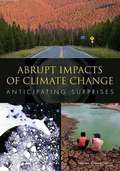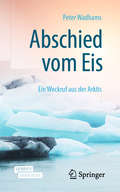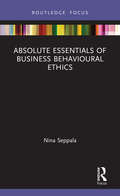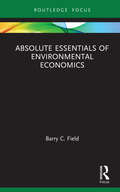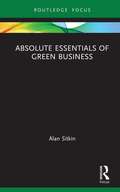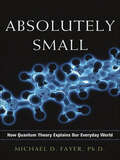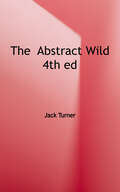- Table View
- List View
Abiotic Stresses in Crop Plants
by Usha Chakraborty Bishwanath ChakrabortyThis book is based to a great extent on the biochemical and molecular mechanisms of tolerance of commonly encountered abiotic stresses in nature. This book will deal with increasing temperature, water, salinity, and heavy metals and ozone, and how these abiotic stresses can be managed by microbes through their alleviation mechanisms. Water stress includes both drought and flooding. 1st section outlines the relevance of abiotic stresses in present day environmental conditions. The 2nd section deals with three major stresses - temperature, water and salinity and the metabolic changes and protective adjustments in plants for withstanding these stresses. The 3rd section deals with the role of heavy metals and ozone. The final section is devoted to general abiotic stresses and their alleviation by microbes. These offer a cost-effective and eco-friendly means of combating different stresses.
About Birds: A Guide for Children (About. . . #1)
by Cathryn SillAn award-winning, educator-approved first book on birds.In this simple volume, educator and author Cathryn Sill uses clear, easy-to-understand language to teach children what birds are, what they do, and how they live. Noted wildlife illustrator John Sill provides beautifully detailed, realistic paintings to showcase the birds' diverse and natural worlds, and an afterword provides more details about each bird and inspires further learning.
About Birds / Sobre los pájaros: A Guide for Children / Una guía para niños (About. . . #17)
by Cathryn SillAn award-winning, educator-approved first book on birds.In this simple volume, educator and author Cathryn Sill uses clear, easy-to-understand language to teach children what birds are, what they do, and how they live. Noted wildlife illustrator John Sill provides beautifully detailed, realistic paintings to showcase the birds' diverse and natural worlds, and an afterword provides more details about each bird and inspires further learning.
About Earth
by Pauline CartwrightPacked with amazing facts, you can wow your friends with everything you know about Earth.
About Habitats: Polar Regions (About Habitats #7)
by Cathryn SillThis beginner's guide and classroom favorite explores the Arctic and Antarctic biomes, their beauty, and global diversity. Author and former early education teacher Cathryn Sill uses simple, easy-to-understand language to teach children what the Polar Regions are—from the frozen deserts of Antarctica to the ice floes of the Arctic Ocean—along with what kinds of animals and plants live there, how they have adapted to life in this environment, and why they're important. Noted wildlife illustrator John Sill offers full-color illustrations depicting the various landscapes and species of animals and plants. A glossary and afterword provide more details for further study. Great for early childhood and elementary units on geography and habitats, nature and environment.
About Habitats: Rivers and Streams
by Cathryn SillA perfect entry for first conversations about waterways and conservation.Author and illustrator team Cathryn and John Sill offer an accessible introduction to rivers and streams, touching on their major attributes, the animals and plants that live there, and their remarkable global diversity. Using simple, easy-to-understand language, the author teaches children what rivers and streams are and explains how various species of animals and plants have adapted to life in or along these waterways. Detailed, full-color art shows the characteristics of the world's different rivers and streams―from the mountain brooks of the Alps to the mighty Amazon River in South America. A glossary and afterword provide further details. Great for casual exploration and for early childhood and elementary education units on nature, environment, earth sciences, and ecosystems.
About Habitats: Tundras (About Habitats #10)
by Cathryn SillThis beginner's guide to tundras explores the unique attributes of this cold habitat, showcasing its beauty and plant and animal diversity. Author and educator Cathryn Sill uses simple, easy-to-understand language to teach children what tundras are, what kinds of animals and plants live there, and how certain species have adapted to the unique environment. The book covers the characteristics of Arctic, Antarctic, and alpine tundras. John Sill's detailed, realistic paintings reflect the beauty and diversity of the habitat. A glossary and afterword provide more detail for further exploration. Ideal for early childhood and elementary education units on biomes and environments, geography, habitats, and nature.
About Insects: A Guide for Children (About. . . #4)
by Cathryn SillThis beginner's guide to insects is a must-have for bug-obsessed young learners as well as for those who are simply curious about these creatures. In this addition to the acclaimed About... series, author and educator Cathryn Sill uses simple, easy-to-understand language to teach children what insects are, how they look, how they move, what they eat, and where they live. With beautifully detailed, realistic paintings, noted wildlife illustrator John Sill introduces readers to a wide variety of insects, from ants and beetles to grasshoppers and the monarch butterfly. An afterword provides further details, inspiring young readers to learn more.
About Insects / Sobre los insectos: A Guide for Children / Una guía para niños (About. . . #18)
by Cathryn SillThis beginner's guide to insects is a must-have for bug-obsessed young learners as well as for those who are simply curious about these creatures. In this addition to the acclaimed About... series, author and educator Cathryn Sill uses simple, easy-to-understand language to teach children what insects are, how they look, how they move, what they eat, and where they live. With beautifully detailed, realistic paintings, noted wildlife illustrator John Sill introduces readers to a wide variety of insects, from ants and beetles to grasshoppers and the monarch butterfly. An afterword provides further details, inspiring young readers to learn more.
About Mammals: A Guide for Children (About. . . #2)
by Cathryn SillAn award-winning first glimpse into the diverse natural world of mammals.This addition to the acclaimed About... series explains to children in simple, easy-to-understand language what mammals are, what they eat, and where they live. Beautifully detailed, realistic paintings by wildlife illustrator John Sill introduce readers to the huge variety of mammals, from the tiny white-footed deermouse to the large American bison. An afterword provides more details about the animals featured in the book. Parents and pre-school and primary-grade teachers will find this an attractive choice for introducing kids to mammals.
About Mammals / Sobre los mamíferos: A Guide for Children / Una guía para niños (About. . . #15)
by Cathryn SillAn award-winning first glimpse into the diverse natural world of mammals.This addition to the acclaimed About... series explains to children in simple, easy-to-understand language what mammals are, what they eat, and where they live. Beautifully detailed, realistic paintings by wildlife illustrator John Sill introduce readers to the huge variety of mammals, from the tiny white-footed deermouse to the large American bison. An afterword provides more details about the animals featured in the book. Parents and pre-school and primary-grade teachers will find this an attractive choice for introducing kids to mammals.
About Marine Mammals: A Guide for Children (About. . . #19)
by Cathryn SillA classroom favorite, this book provides a first glimpse of marine mammals that's ideal for budding oceanographers!In this beginner's guide, author and educator Cathryn Sill simply and clearly shows children what is essential for understanding and appreciating marine mammals—how they look, how they move, what they eat, and where they live. She covers animals as diverse as whales and otters to dolphins, polar bears, and more. The beautifully detailed, realistic paintings of noted wildlife illustrator John Sill depict a variety of marine mammals. An afterword provides more details for further exploration.
About The Ocean (We Both Read)
by Sindy MckayThe First Books Designed for Shared Reading" Introducing the easiest and most enjoyable way to help and encourage children to read! We Both Read is designed to invite parents and children to share the reading of a book by taking turns reading aloud. Parents read the more sophisticated text on the left-hand pages and children read the right-hand pages, which have been written at one of the three early reading levels. Developed with reading education specialists, this delightful new series brings parents and children together for a wonderful new reading experience and faster reading development! "We Both Read is the series we have all been waiting for: books that enable parents to help their children learn to read while having fun together. This is the most appealing and effective innovation for young readers that I have seen in many years!" - Thelma Reese, Ed.D., Reading Education Specialist and Chairperson of the Children's Literacy Initiative About the Ocean The oceans come alive in this new non-fiction title in the We Both Read series. Filled with beautiful photographs, this book explores many aspects of the ocean environment that will excite readers, both young and old! Journey from coral reefs to deep seas to sandy shores. Learn interesting facts about life in the ocean, including dolphins, sharks, whales, starfish and much more!
About Parrots: A Guide for Children (About. . . #16)
by Cathryn SillA beautiful, informative first glance at the world of parrots.In this addition to the acclaimed About... series, author and educator Cathryn Sill uses simple, easy-to-understand language to teach children what parrots are, what they do, and how they live. With beautifully detailed, realistic paintings, noted wildlife illustrator John Sill introduces readers to the diverse population of parrots—from the colorful blue lorikeets of the Polynesian Islands to the rosy-faced lovebirds of southwestern Africa. An afterword provides more details for further exploration.
About Star Architecture: Reflecting on Cities in Europe
by Davide Ponzini Alain Thierstein Nadia Alaily-MattarCities across the world have been resorting to star architects to brand their projects, spark urban regeneration and market the city image internationally. This book shifts the attention from star architects to star architecture, arguing that the process of deciding about and implementing relevant architectural and urban projects is not the product of any single actor. Star architecture can, in fact, be better studied and understood as assembled by multiple actors and in its relationship with urban transformation. In its 18 chapters, the book presents a multidisciplinary collection of expert contributions in the fields of urban planning, architecture, media studies, urban economics, geography, and sociology, consistently brought together for the first time to deal with this topic. Through a vast array of case studies and analytical techniques touching over 20 cities in Europe, the book shows the positive and more problematic impacts of star architecture with reference to the preservation of built heritage, tourism and media. The book will be of interest to architects, sociologists, urban planners, and public administrators.
Aboveground–Belowground Community Ecology (Ecological Studies #234)
by Takayuki Ohgushi Susanne Wurst Scott N. JohnsonResearchers now recognize that above- and belowground communities are indirectly linked to one another, often by plant-mediated mechanisms. To date, however, there has been no single multi-authored edited volume on the subject. This book remedies that gap, and offers state-of-the art insights into basic and applied research on aboveground-belowground interactions and their functional consequences. Drawing on a diverse pool of global expertise, the authors present diverse approaches that span a range of scales and levels of complexity.The respective chapters provide in-depth information on the current state of research, and outline future prospects in the field of aboveground-belowground community ecology. In particular, the book’s goal is to expand readers’ knowledge of the evolutionary, community and ecosystem consequences of aboveground-belowground interactions, making it essential reading for all biologists, graduate students and advanced undergraduates working in this rapidly expanding field. It touches on multiple research fields including ecology, botany, zoology, entomology, microbiology and the related applied areas of biodiversity management and conservation.
Abrupt Climate Change: Inevitable Surprises
by Committee on Abrupt Climate ChangeThe National Academies Press (NAP)--publisher for the National Academies--publishes more than 200 books a year offering the most authoritative views, definitive information, and groundbreaking recommendations on a wide range of topics in science, engineering, and health. Our books are unique in that they are authored by the nation's leading experts in every scientific field.
Abrupt Climate Change
by Leonid Polyak Ellen Mosley-Thompson Harunur RashidPublished by the American Geophysical Union as part of the Geophysical Monograph Series, Volume 193.Abrupt Climate Change: Mechanisms, Patterns, and Impacts brings together a diverse group of paleoproxy records such as ice cores, marine sediments, terrestrial (lakes and speleothems) archives, and coupled ocean-atmosphere climate models to document recent advances in understanding the mechanisms of abrupt climate changes. Since the discovery of the Dansgaard-Oeschger events in Greenland ice cores and the subsequent discovery of their contemporary events in the marine sediments of the North Atlantic, the search for these abrupt, millennial-scale events across the globe has intensified, and as a result, the number of paleoclimatic records chronicling such events has increased. The volume highlights include discussions of records of past climate variability, meridional overturning circulation, land-ocean-atmosphere interactions, feedbacks in the climate system, and global temperature anomalies. Abrupt Climate Change will be of interest to students, researchers, academics, and policy makers who are concerned about abrupt climate change and its potential impact on society.
Abrupt Impacts of Climate Change
by Committee on Understanding and Monitoring Abrupt Climate Change and Its Impacts National Research Council Board on Atmospheric Sciences and Climate Division on Earth and Life StudiesClimate is changing, forced out of the range of the past million years by levels of carbon dioxide and other greenhouse gases not seen in the Earth's atmosphere for a very, very long time. Lacking action by the world's nations, it is clear that the planet will be warmer, sea level will rise, and patterns of rainfall will change. But the future is also partly uncertain -- there is considerable uncertainty about how we will arrive at that different climate. Will the changes be gradual, allowing natural systems and societal infrastructure to adjust in a timely fashion? Or will some of the changes be more abrupt, crossing some threshold or "tipping point" to change so fast that the time between when a problem is recognized and when action is required shrinks to the point where orderly adaptation is not possible? Abrupt Impacts of Climate Change is an updated look at the issue of abrupt climate change and its potential impacts. This study differs from previous treatments of abrupt changes by focusing on abrupt climate changes and also abrupt climate impacts that have the potential to severely affect the physical climate system, natural systems, or human systems, often affecting multiple interconnected areas of concern. The primary timescale of concern is years to decades. A key characteristic of these changes is that they can come faster than expected, planned, or budgeted for, forcing more reactive, rather than proactive, modes of behavior. Abrupt Impacts of Climate Change summarizes the state of our knowledge about potential abrupt changes and abrupt climate impacts and categorizes changes that are already occurring, have a high probability of occurrence, or are unlikely to occur. Because of the substantial risks to society and nature posed by abrupt changes, this report recommends the development of an Abrupt Change Early Warning System that would allow for the prediction and possible mitigation of such changes before their societal impacts are severe. Identifying key vulnerabilities can help guide efforts to increase resiliency and avoid large damages from abrupt change in the climate system, or in abrupt impacts of gradual changes in the climate system, and facilitate more informed decisions on the proper balance between mitigation and adaptation. Although there is still much to learn about abrupt climate change and abrupt climate impacts, to willfully ignore the threat of abrupt change could lead to more costs, loss of life, suffering, and environmental degradation. Abrupt Impacts of Climate Change makes the case that the time is here to be serious about the threat of tipping points so as to better anticipate and prepare ourselves for the inevitable surprises.
Abschied vom Eis: Ein Weckruf aus der Arktis
by Peter WadhamsDas Meereis der Polargebiete ist nicht nur wunderschön, es reguliert auch die Temperatur der Erde. Doch es zieht sich zurück – und zwar schnell! Dabei laufen komplexe Rückkopplungen ab, die das Potenzial haben, den Klimawandel zu beschleunigen und zu verstärken. Der britische Polarforscher Peter Wadhams ist einer der international führenden Meereisexperten. Er greift auf seine fast lebenslange Forschung in der Arktis zurück, um zu erklären, was gerade passiert, was das für unsere Zukunft bedeutet – und was wir tun können und müssen.Der AutorPeter Wadhams ist einer der weltweit erfahrensten Polar- und Meereisforscher. Er war von 1987–92 Direktor des Scott Polar Institute in Cambridge und dort auch von 1992–2015 Professor für Physik der Ozeane. Er war an mehr als 50 Expeditionen in beide Polarregionen beteiligt – in Forschungscamps, auf Eisbrechern, von Flugzeugen aus, und sogar in Unterseebooten. Er wurde ausgezeichnet mit dem W. S. Bruce-Preis der Royal Society of Edinburgh (1977), der UK Polar Medal (1987) und dem Italgas-Preis für Umweltwissenschaften (1990). Er ist Fellow der Royal Geographical Society und Mitglied der Finnischen Akademie.
Absolute Essentials of Business Behavioural Ethics (Absolute Essentials of Business and Economics)
by Nina SeppalaBehavioural ethics in business is an emerging field that has challenged some of the established wisdom about ethics and added some truly new insights into our understanding about decision-making and behaviour. Why do seemingly responsible employees and managers sometimes act in bad ways? This book explains how people behave in real situations and what action can be taken to nudge behaviour in a more ethical direction. This concise textbook is ideal for use in the classroom as core or additional reading on courses in business ethics and corporate social responsibility; organisational behaviour and psychology; and any module with ethics content (for example, accounting ethics and strategic management). Each chapter is presented as a story with details about the experimental designs and related research findings. The key features include learning outcomes, suggested class activities, mock assessment questions, and an annotated list of key readings and these provide a one-stop text for tutors and students interested in this increasingly important area of study.
Absolute Essentials of Environmental Economics (Absolute Essentials of Business and Economics)
by Barry C. FieldThis shortform textbook provides a concise overview of the fundamentals of environmental economics. It focuses on how economic forces affect the natural environment and how economic policies and behaviors may be altered to improve environmental quality. Spanning ten chapters, the book introduces readers to the key ideas in environmental economics. Topics include environmental externalities, technological change, cost-benefit analysis, pollution charges, emissions and offset trading, climate change, and public policy. Written by an established educator and scholar, Absolute Essentials of Environmental Economics will be valuable reading for students of environmental economics, environmental policy, environmental management and related areas. People affiliated with environmental interest groups, "think tanks," and advocacy groups will also find it beneficial.
Absolute Essentials of Green Business (Absolute Essentials of Business and Economics)
by Alan SitkinThis short textbook provides a core understanding of the intersection between business and the natural environment. The sector’s rapid expansion means that many university programmes are focusing to a greater extent nowadays on the career opportunities generated by the ecological imperative – a curriculum increasingly referred to as "green business". Climate breakdown is a devastating issue facing contemporary society. With six out of the ten largest multinationals listed in the 2018 Fortune Global 500 being active in the energy sector, it is no surprise that more and more business schools are offering modules addressing the management of natural resources. The business world has made some progress incorporating green principles into their strategies and operations, but progress needs to accelerate in line with global agreements to prevent catastrophic ecological and environmental problems. Absolute Essentials of Green Business stands out because of its singular focus on a subset of this wider curricular area. By covering both the macro (framework) and micro (business strategy) aspects of the topic, the book’s structure is in line with the way modules of this nature are taught in universities today. Students of business and environmental studies will benefit from reading this concise textbook in order to develop their understanding of a fundamental element of the social science curriculum.
Absolutely Small: How Quantum Theory Explains Our Everyday World
by Michael D. FayerAbsolutely Small presents (and demystifies) the world of quantum science like no book before.Physics is a complex, daunting topic, but it is also deeply satisfying?even thrilling. When liberated from its mathematical underpinnings, physics suddenly becomes accessible to anyone with the curiosity and imagination to explore its beauty. Science without math? It&’s not that unusual.For example, we can understand the concept of gravity without solving a single equation. So for all those who may have pondered what makes blueberries blue and strawberries red; for those who have wondered if sound really travels in waves; and why light behaves so differently from any other phenomenon in the universe, it&’s all a matter of quantum physics.This book explores in considerable depth scientific concepts using examples from everyday life, such as:particles of light,probability,states of matter,what makes greenhouse gases badChallenging without being intimidating, accessible but not condescending, Absolutely Small develops your intuition for the very nature of things at their most basic and intriguing levels.
The Abstract Wild
by Jack TurnerIf anything is endangered in America it is our experience of wild nature—gross contact. There is knowledge only the wild can give us, knowledge specific to it, knowledge specific to the experience of it. These are its gifts to us. <p><p>How wild is wilderness and how wild are our experiences in it, asks Jack Turner in the pages of The Abstract Wild. His answer: not very wild. National parks and even so-called wilderness areas fall far short of offering the primal, mystic connection possible in wild places. And this is so, Turner avows, because any managed land, never mind what it's called, ceases to be wild. Moreover, what little wildness we have left is fast being destroyed by the very systems designed to preserve it. <p><p>Natural resource managers, conservation biologists, environmental economists, park rangers, zoo directors, and environmental activists: Turner's new book takes aim at these and all others who labor in the name of preservation. He argues for a new conservation ethic that focuses less on preserving things and more on preserving process and "leaving things be." He takes off after zoos and wilderness tourism with a vengeance, and he cautions us to resist language that calls a tree "a resource" and wilderness "a management unit." <p><p>Eloquent and fast-paced, The Abstract Wild takes a long view to ask whether ecosystem management isn't "a bit of a sham" and the control of grizzlies and wolves "at best a travesty." Next, the author might bring his readers up-close for a look at pelicans, mountain lions, or Shamu the whale. From whatever angle, Turner stirs into his arguments the words of dozens of other American writers including Thoreau, Hemingway, Faulkner, and environmentalist Doug Peacock. We hunger for a kind of experience deep enough to change our selves, our form of life, writes Turner. Readers who take his words to heart will find, if not their selves, their perspectives on the natural world recast in ways that are hard to ignore and harder to forget.
